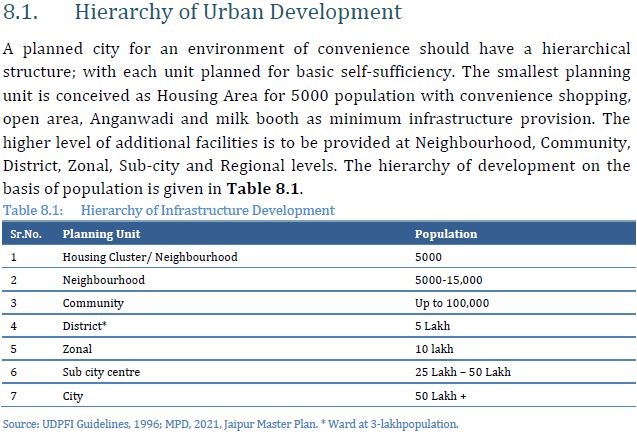URBAN AND
REGIONAL DEVELOPMENT PLANS FORMULATION AND IMPLEMENTATION GUIDELINES
Urban Settlements
The classification of urban settlements adopted by the Census of India 2011 is as
follows:
1. All places with a Municipality, Corporation, Cantonment Board or notified town
area committee, etc.
2. All other places which satisfies the following criteria:
a. A minimum population of 5,000;
b. At least 75 per cent of the male main working population engaged in non-agricultural
pursuits; and
c. A density of population of at least 400 persons per sq. km.
Perspective Plan 20‐30 years
To develop vision and provide a policy framework for urban & regional development and further detailing
Regional Plan 20 years
To identify the region and regional resources for development within which settlement (urban and rural) plan to be prepared and regulated by DPC.
Development Plan 20‐30 years (Review every 5 years)
To prepare a comprehensive Development Plan for urban areas, Peri‐urban areas under control of Development authority/ Metropolitan Planning Committee.
Local Area Plan 5‐20 year (Review every 5 yrs)
To detail the sub‐city land use plan and integration with urban infrastructure, mobility and services.
Transit Oriented Development (TOD)
The integration of land use with transport systems is called “Transit Oriented Development”, which is essentially “any development, macro or micro that is focused around a transit node, and facilitates complete ease of access to the transit facility thereby inducing people to prefer to walk and use public transportation over personal modes of transport”.
Sustainable Waste Management
International agencies working on zero waste have claimed that recycling rates of 75% and plus have been achieved by municipalities large and small throughout the world. The ‘Zero waste’/‘Zero Land‐fill’ concept is gaining ground as being practicably achievable in Indian cities too. Indian cities have the advantage of significant recycling and reuse in the solid waste management system. Those can be
improved and coordinated with the view to moving towards ‘Zero waste scenarios’.
Implications of 73rd & 74th Constitution Amendment Act, 1993
The main provisions introduced by the Act are as under:
1) Constitution of Panchayats and Municipalities:
Article 243 B of 73rd CAA, provides for the constitution of Panchayats at three levels in a state:
a) Village,
b) Intermediate (may not be constituted in a State having a population not
exceeding twenty lakhs) and
c) District.
Article 243 Q of 74th CAA, provides for constitution of Municipalities in every State as
given under:
a) Nagar Panchayat for transitional area, that is to say, an area in transition from
rural to urban in character.
b) Municipal Council for a smaller urban area, and
c) Municipal Corporation for a larger urban area.
2) Constitution of Ward Committees: Article 243 S provides for constitution of ward committees, consisting of one or more wards, within the territorial area of a Municipality having a population of
3, 00,000 or more.
3) Duration of Municipalities: Article 243 E of 73rd CAA and 243 U of 74th CAA, provides a fixed term of 5 years of a panchayat and municipality respectively, from the date appointed. Elections to constitute a panchayat or municipality are required to be completed before the expiration of the duration of the municipality.
4) Powers, authority and responsibilities of Panchayats and Municipalities: Article 243G of 73rd and 243W of 74th CAA provides powers, authority and responsibilities of Municipalities subject that legislature of the State by law endow:
a) The Panchayats and Municipality with such powers and authority those are necessary to enable them to function as institutions of selfgovernment. The law prepared by the state government may contain provisions for the devolution of powers and responsibilities upon Municipalities, with or without conditions with respect to
i. the preparation of plans for economic development and social justice;
ii. the performance of functions and implementation of schemes as may be entrusted to them including those in relation to the matters listed in the Eleventh and Twelfth Schedule;
b) The Committees with such powers and authority as may be necessary to
enable them to carry out the responsibilities conferred upon Municipalities
them including those in relation to the matters listed in the Twelfth Schedule.































No comments:
Post a Comment